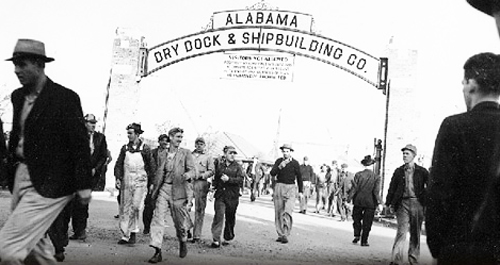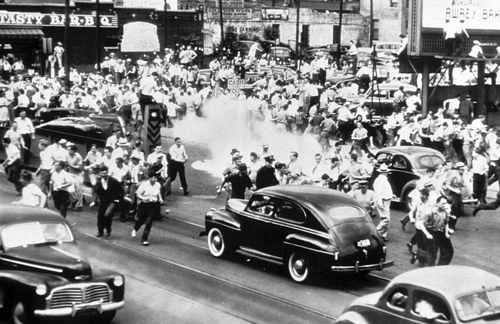MEMORIAL DAY 2015 IV: The hypocrisy of the propaganda for the so-called 'Greatest Generation...' ...that legacy was segregation, lynch law, and race riots from Mobile to Detroit to Los Angeles... How the Confederate Flag was raised on Okinawa before the Stars and Stripes!....
Memorial Day is May 31, 2015, despite the fact that the holiday is now marked on difference days, some as far as a week away from the actual date. But it's again time to stop and think about the propaganda that Americans have to cut through to understand some of the realities that make Memorial Day more complex than the simplifications we hear today in most of the corporate media.
 When federally funded ship building in Mobile Alabama required that black workers to skilled work, the majority of the white workers at the ship building companies in Mobile rioted, declaring that black men (the actual descriptive was much less neutral) would never be allowed to weld in Alabama. Like Detroit and other cities, the riots during World War II were also reflected in the racism within many of the armed services at that time.Although one of the greatest books about war is Eugene Sledge's "With the Old Breed," readers and history shouldn't ignore certain facts that accompany the narrative of the suffering of the Marines moving south on Okinawa through the mud and rains of May and early June 1945:
When federally funded ship building in Mobile Alabama required that black workers to skilled work, the majority of the white workers at the ship building companies in Mobile rioted, declaring that black men (the actual descriptive was much less neutral) would never be allowed to weld in Alabama. Like Detroit and other cities, the riots during World War II were also reflected in the racism within many of the armed services at that time.Although one of the greatest books about war is Eugene Sledge's "With the Old Breed," readers and history shouldn't ignore certain facts that accompany the narrative of the suffering of the Marines moving south on Okinawa through the mud and rains of May and early June 1945:
"About midmorning on 29 May, 3/5 attacked the Shuri with Company L in the lead and companies K and I following closely. Earlier in the morning, Company A, 1st Battalion, 5th Marines had attacked eastward into the rains of Shuri Castle and raise the Confederate flag. When we learned that the flag of the Confederacy had been hoisted over the very heart and soul of the Japanese resistance, all of us Southerners [Sledge was from Alabama] cheered loudly. The Yankees among us grumbled, and the Westerners didn't know what to do..."
While Tom Hanks of Hollywood rightly praises the courage of the Marines on Okinawa, and the Hollywood production of "The Pacific" does a good job of depicting the horrors of the island wars fought mostly by the Marines (by Okinawa, there were two Army divisions, which were integrated, and two Marine divisions, which were still segregated, doing the fighting on Okinawa), those who wish to binge on "The Pacific" might want to note its strange similarity to "Forrest Gump" and other narratives that were overly sympathetic to the slave states of America and the nastiest of the slavers (in the case of Forrest Gump, the founder of the KKK, Nathan Bedford Forrest). Hollywood propaganda may be closer to the hearts of Americans, but it is still propaganda.
Okinawa was a reality in my family because my mother served with the U.S. Army Nurse Corps in a field hospital on the island during the battle, which lasted at its worst from April 1, 1945 through early July 1945. The post-traumatic stress and nightmares from those months were part of our family's reality during the 1950s, 1960s, 1970s and into the 1980s (when my mother died).
Those who are interested in an accurate history of the era, then, have to face the complexity of white supremacy at the time. The heroism of the Marines on Okinawa, memorably described in Sledge's book and others, cannot be denied. But as "The Pacific" notes, by focusing on the Marines, the sacrifices were made by virtually all "white" service men (Ira Hayes and a few Native Americans and Latinos were considered whites for Marine purposes; African Americans were excluded from combat units...). There are many good accounts of how difficult it was to force the desegregation of the U.S. Marine Corps, so anyone interested can read them. One of the most extensive is available readily on line.
While President Truman ordered the desegregation of the armed forces in 1948 (the same time that Jackie Robinson was desegregating Major League baseball), there is as yet (in 2015) no "42" to cover the trials faced by the men who wanted to be "real" (meaning combat) U.S. Marines during the battles of the Second World War.
At home, race riots peaked during 1943 and gave the Nazis food for their own propaganda machines. As LIFE magazine described the scene in June 1943:
 One of the many photos of the scenes from the Detroit race riot of June 1943.�In 1943, race riots convulsed cities around the U.S., from Southern California�s infamous �Zoot Suit riots� in early June to widespread conflicts in St. Louis, New York, Baltimore and elsewhere. But no riots that year were as deadly, and few lasted as long, as the three days of violence that jolted Detroit in late June. Sparked by seemingly minor altercations amid aggressive white resistance to black labor flocking to the city�s factories during America�s ramped up war effort, the Detroit riots (June 20 � 22) killed 34 people � 25 African Americans and nine whites � wounded hundreds more and damaged and destroyed property worth millions��
One of the many photos of the scenes from the Detroit race riot of June 1943.�In 1943, race riots convulsed cities around the U.S., from Southern California�s infamous �Zoot Suit riots� in early June to widespread conflicts in St. Louis, New York, Baltimore and elsewhere. But no riots that year were as deadly, and few lasted as long, as the three days of violence that jolted Detroit in late June. Sparked by seemingly minor altercations amid aggressive white resistance to black labor flocking to the city�s factories during America�s ramped up war effort, the Detroit riots (June 20 � 22) killed 34 people � 25 African Americans and nine whites � wounded hundreds more and damaged and destroyed property worth millions��

